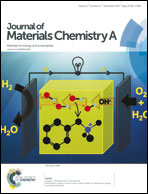Mechanistic analysis of ammonium cation stability for alkaline exchange membrane fuel cells†
Abstract
Improving long-term cation stability is crucial for adopting anion exchange membrane fuel cells as a commercially viable technology in clean energy conversion applications. To reliably identify the most stable cation structures, we analyzed the cation stability of various synthetically prepared quaternary ammonium organic molecules via a silver oxide ion exchange reaction. This method enabled us to compare the stability of various structures of quaternary ammonium hydroxide in pure form in water without excess alkaline solution or inconsistencies faced in the presence of polymer backbones. By quantitatively comparing cation degradation via NMR, we were able to identify three cation structures with greater cation stability than the most well-known benzyltrimethylammonium. In addition, we were able to elucidate byproduct formation and degradation mechanisms as a result of hydroxide attack. From this study we concluded that alkyl-substituted cations seem to impart greater stability than benzylic-substituted cations in the presence of hydroxide anions in aqueous solution.


 Please wait while we load your content...
Please wait while we load your content...